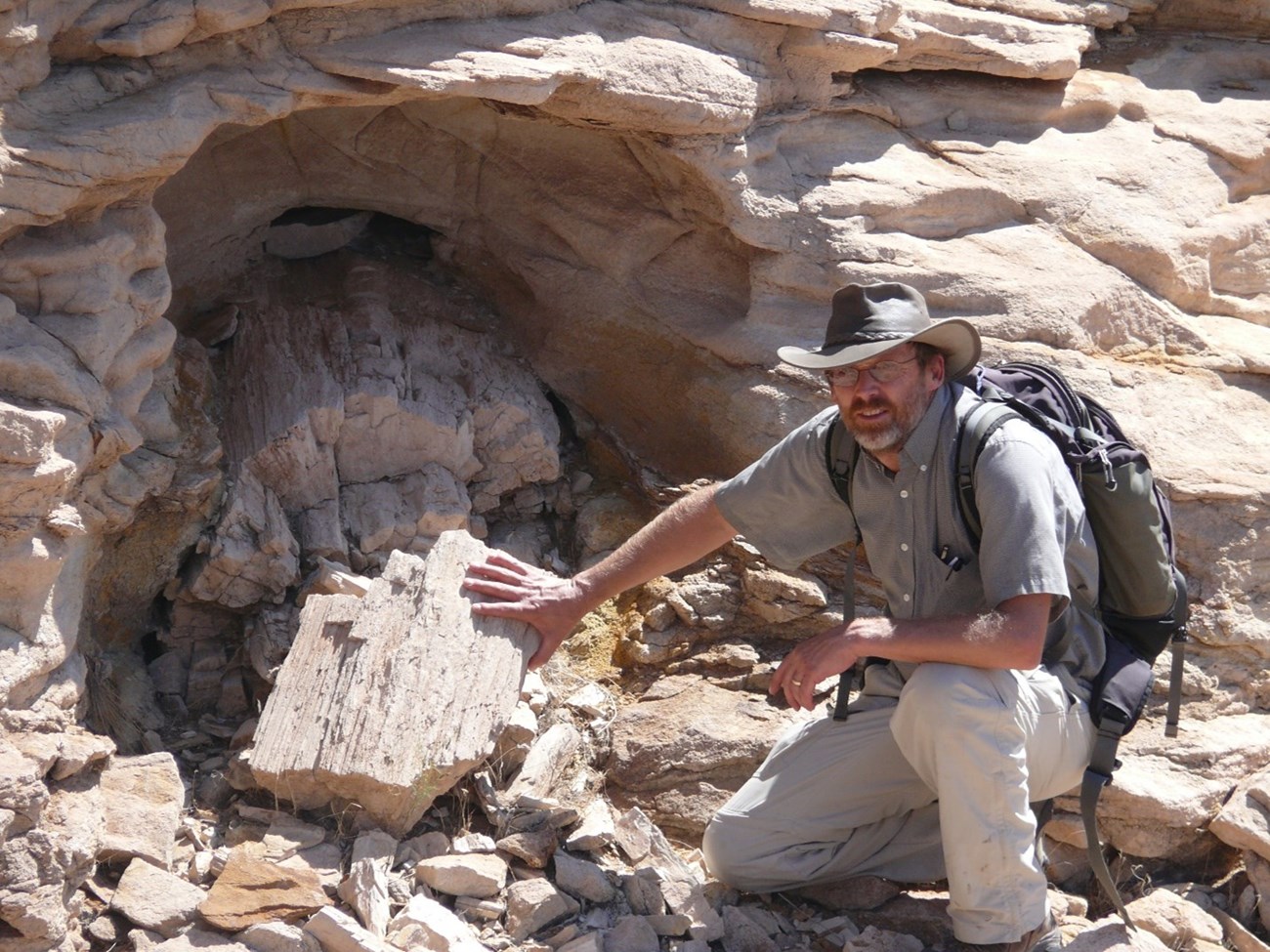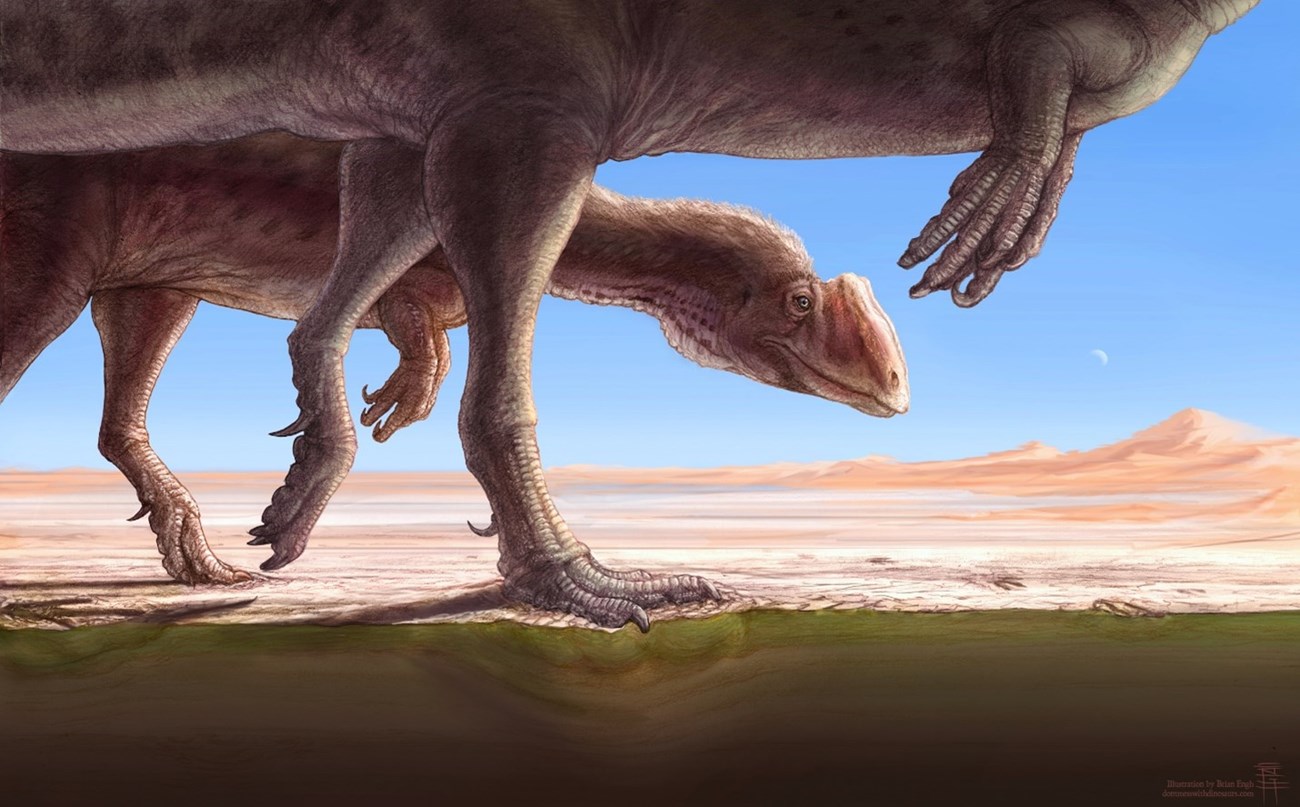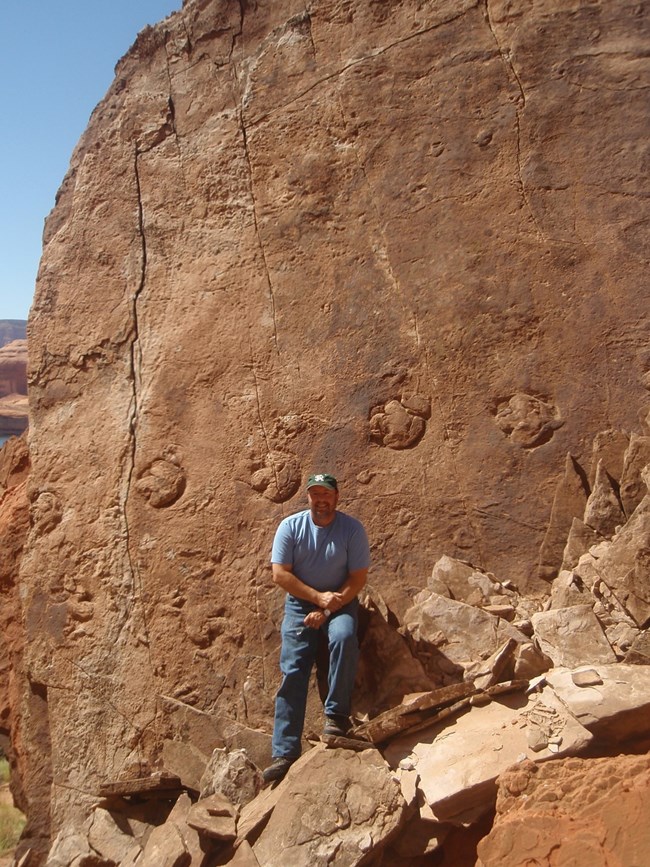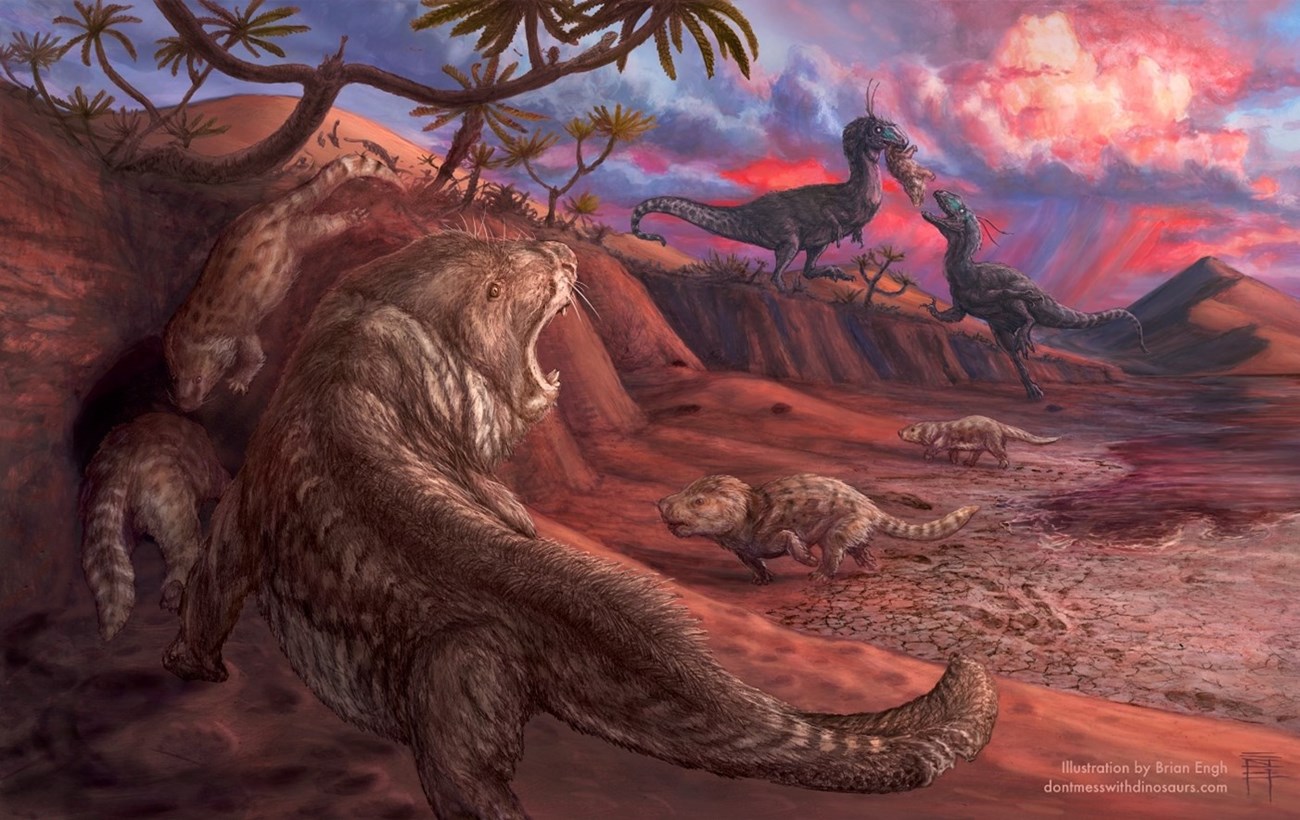Part of a series of articles titled National Fossil Day Logo and Artwork – Prehistoric Life Illustrated.
Article
Fossils of the 2024 National Fossil Day Artwork

Glen Canyon National Recreation Area: Tracking Ancient Life along the Colorado River
The desert vistas, canyonlands, and the waters of Lake Powell attract almost 3 million people each year to Glen Canyon National Recreation Area. Visitors enjoy the natural splendor of this region for hiking, camping, and boating. The canyons surrounding and hosting the Lake Powell reservoir were carved by the Colorado River and its smaller tributaries. Established in 1972, Glen Canyon National Recreation Area consists of 1,254,429 acres set aside for public use and enjoyment and to preserve the area's scientific, historic, and scenic features. The recreation area contains a varied geologic story that begins approximately 310 million years ago. This geologic story told within the rocks tells of environmental change over time and the organisms that adapted to these environments.
The oldest rocks within the recreation area date to the Pennsylvanian and Permian periods of the late Paleozoic Era and record the ebb and flow of tropical coastal seas and coastal swamps between approximately 310 million years ago and 252 million years ago. Early sharks patrolled these seas and ancient reefs, while early reptiles and amphibians lived within the coastal forests in rocks that are part of the Cutler Group and later Permian marine limestones. Occasionally the seas left the area and were replaced by areas of sand dunes, now preserved as sandstone beds.
The great Permian/Triassic Extinction event 252 million years ago saw a great reduction in the diversity of life, but plants and animals slowly rebounded and diversified during the Triassic, which is recorded in the Moenkopi and Chinle Formations. By the Late Triassic (Chinle Formation), conifer forests along river channels were common and large reptiles (including early dinosaurs) and amphibians were the dominant creatures on land.

NPS photo.
Later Cretaceous rocks within Glen Canyon National Recreation Area demonstrate the formation of a Great Interior Seaway some 100 million years ago that would divide the North American continent into two landforms, Appalachia in the east and Laramidia in the west. This seaway, represented primarily by the Tropic Shale, shows evidence of large marine reptiles, as well as sharks, large bony fish, and ammonites, leaving isolated teeth, occasional skeletons, and other material to be preserved in the marine sediments. Dinosaur carcasses are also occasionally found within these marine sediments, suggesting these creatures lived along the nearby eastern coastline of ancient Laramidia. Younger dinosaur and other fossils from coastal deposits (the Straight Cliffs and Wahweap Formations) dating between 80–70 million years ago demonstrate the slow retreat of the Great Interior Seaway during the Late Cretaceous.
However, although these rocks have all provided significant discoveries, Glen Canyon National Recreation Area’s best known fossils come from the early beginnings of the Jurassic Period, when dinosaurs began their true reign on our planet. A number of amazing and surprising discoveries dating to this time are what inspired the 2024 National Fossil Day artwork.
Evidence of Life of the Glen Canyon Group

Art by Brian Engh.
The waters of the Colorado River’s Lake Powell and bordering canyonlands lap up against strata of the Glen Canyon Group, a series of sedimentary rocks that date from the latest Triassic to Early Jurassic. These rocks represent a series of eolian (wind-blown sands), flood plain, and oasis (desert perennial springs) settings during which dinosaurs began to diversify into larger and more complex forms. The oldest set of rocks of the Glen Canyon Group is the Wingate Sandstone, which represents a dry desert environment of wind-blown sand dunes deposited at the very tail end of the Triassic and into the early beginnings of the Jurassic, approximately 200 million years ago. Tracks of large reptiles, early mammal relatives, and dinosaurs are well-known from the Wingate Sandstone and Moenave Formation. Even fossils of nearly complete fish and some crocodiles have been found in the Moenave Formation west of Glen Canyon National Recreation Area, near St. George Utah.
Above the Wingate Sandstone is the Kayenta Formation, which represents a series of small springs, ponds, lakes, and rivers that cut through a generally arid landscape. The Kayenta Formation has a very diverse fossil record consisting of both trace fossils (tracks) and body fossils of plants and animals. Evidence for oasis-like environments comes from fossils of fish (including freshwater sharks and coelacanths), amphibians (including early frogs, salamanders, and caecilians), early turtles, and crocodiles. Other reptiles found in the Kayenta Formation include rhynchocephalians (early relatives of the tuatara of New Zealand) and pterosaurs. Fossils of dinosaurs including large to small theropods, early sauropods, and small to large thyreophorans (armored herbivorous dinosaurs) as well as corresponding tracks are known from within the Kayenta Formation. A number of species of early mammal relatives and evidence of their trackways have also been identified. Other trace fossil evidence has been found for worms, crustaceans, insects, and fish (swimming traces). Fossils of plants such as cycads and ferns are also known.

NPS photo.
The youngest geologic horizon of the Glen Canyon Group is the Navajo Sandstone, which represents an arid erg. An erg is a sand-dune field with little to no vegetation cover, but can occasionally support seasonal ponds during monsoon rains. These environmental conditions allow for tracks and occasional vertebrate body fossils (such as bones and teeth) to be preserved. Early small sauropod relatives such as Seitaad are known from partially articulated skeletons of animals buried over by sand dunes. Tracks of a large theropod and the skeleton of the small theropod Segisaurus have been found as well.
The 2024 National Fossil Day art depicts a scene that combines aspects of the upper Glen Canyon Group (Kayenta Formation and Navajo Sandstone) at Glen Canyon National Recreation Area. A lone Dilophosaurus is cresting the top of a sand dune, following the tracks of a group of smaller plant-eating dinosaurs, leaving their tracks as well in the sands. A group of Scutellosaurus, a small armored herbivorous dinosaur, make their way over the next dune to avoid the Dilophosaurus. A family of tritylodonts, a type of early mammal relative, are looking for food among the vegetation growing within the oasis that formed between the sand dunes during the last monsoon rains.
The Giant Crested Hunter: Dilophosaurus
First discovered in northern Arizona in 1942 in the Kayenta Formation by University of California paleontologist, Dilophosaurus wetherilli is known from a number of partial skeletons. The apex predator of its time, Dilophosaurus is estimated to have reached about 23 feet long and more than 850 lbs., and would have fed on early sauropods, Scutellosaurus, early mammal relatives, and fish. Its most distinctive feature was the presence of a pair of tall thin arched head crests, which gives its name meaning “two-crested lizard”. The crests may have functioned as a display organ, covered with a horn-like keratin covering, similar to a cassowary’s crest today. Tracks referred to as Eubrontes, which are found at Glen Canyon National Recreation Area in the Navajo Sandstone, have been suggested to have been made by Dilophosaurus or something very similar in size and anatomy The most famous of these trackways at Glen Canyon National Recreation Area is called the John Wesley Powell Track Block, which is a massive rock with tracks on its vertical surface. Eubrontes tracks have also been found in other latest Triassic to Early Jurassic sites in Utah, Arizona, Connecticut, Virginia, and Maryland, as well as France, Poland, Slovakia, the Czech Republic, Italy, Spain, Sweden, Australia, India, and China.
The Little Armored Herbivore: Scutellosaurus

First described in 1981 from partial skeletons from northern Arizona, Scutellosaurus lawleri is a small early member of the Thyreophora, the group of armored dinosaurs that contains Stegosaurus and Ankylosaurus. Like its larger relatives, Scutellosaurus had several hundred small bones in its skin called osteoderms. These osteoderms were laid out in rows along its neck, back, the sides of its belly, and tail. These osteoderms are what gives Scutellosaurus its name, meaning “little-shielded lizard”. Scutellosaurus was a small dinosaur at approximately 4 feet in length, with a narrow beaked skull with spade-like teeth for consuming plants. From the length of its arms and legs, Scutellosaurus was able to walk on all four as well as possibly run on its hind legs to escape predators. Trackways referred to Anomoepus have been found in the Glen Canyon National Recreation Area and may have been made by Scutellosaurus, demonstrating it both walking with four limbs, and running on its hind legs. Tracks of Anomoepus have also been found elsewhere in latest Triassic to Early Jurassic sites in Utah, Arizona, Connecticut, western Australia, Poland, and the Czech Republic.
Raising a Family Underground: the Tritylodonts

In early 2023, an amazing discovery was made along the shores of Lake Powell. The recent drought conditions had caused Lake Powell to be at a historic low level that year, spurring the National Park Service to make a paleontological resource assessment of the newly exposed strata. A number of new Early Jurassic track sites were recorded during this assessment. Beyond that, a unique bone bed site was identified that had body fossils of a rare group of animals in the Glen Canyon Group: early mammal relatives! These creatures, called tritylodonts, had jaw joints retained from their more reptile-like cynodont ancestors but also had pelvic structures more like living monotremes (such as the platypus and echidna), suggesting they laid eggs. These considerations suggest that tritylodonts may have had a “sister-relationship” with our true mammal family branch, sharing a common ancestor. The tritylodont bone bed was discovered in the Navajo Sandstone and contained more than a dozen individuals found in a small area, many of which were articulated. This suggests they all were caught in a catastrophe that covered them quickly to be preserved in their entirety. They may have been a burrowing community similar to some extant rodents (like prairie dogs) that had their burrows fill or collapse suddenly. There is also evidence of small theropod dinosaur tracks within the bone bed horizon as well. This new discovery of rare early mammal relatives will help us understand the diversity and evolution of our own mammal family tree. In addition, these kinds of discoveries help paleontologists recreate the most accurate imagery of what life was like during the Early Jurassic and showcase the importance of diligent fossil resource monitoring and conservation for our public lands!

A reconstruction of the Early Jurassic tritylodont bone bed site in the Navajo Sandstone at Glen Canyon National Recreation Area.
Art by Brian Engh.
Related Links
-
Glen Canyon National Recreation Area (GLCA), Arizona and Utah—[GLCA Geodiversity Atlas] [GLCA Park Home] [GLCA npshistory.com]
-
Learn more about National Fossil Day and the NFD Logos and Artwork.
-
To download the National Fossil Day 2024 Glen Canyon Jurassic artwork, click here.
Last updated: August 5, 2024
